Hangul 김창열 Name Kim Tschang-yeul McCune–Reischauer Kim Ch'angyol | Hanja 金昌烈 | |
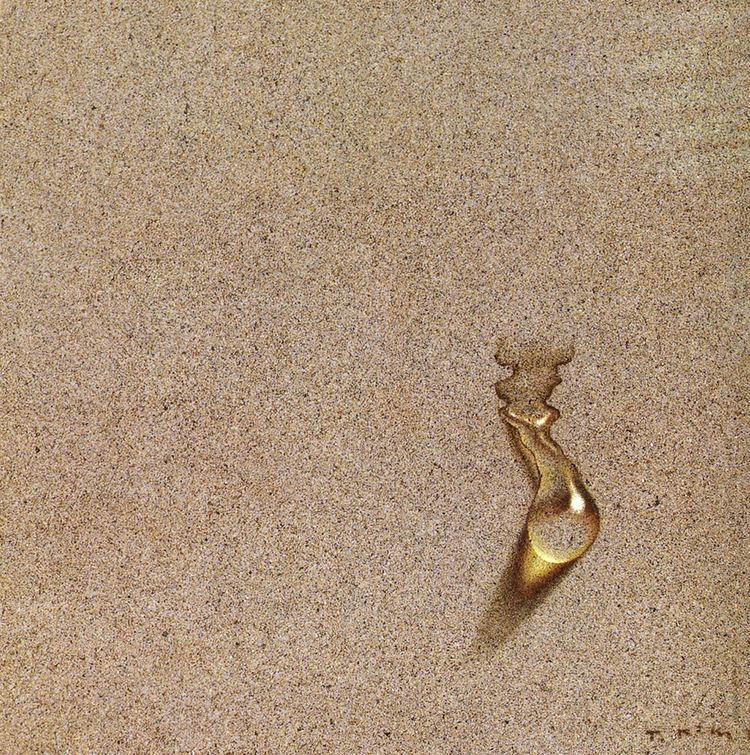 | ||
Revised Romanization Gim Chang-yeol | ||
the master of water drops in jeju kim tschang yeul museum
Kim Tschang Yeul (also known as "김창열","Kim Tchangyeul", "Kim Chang Yeul", or "Tschangyeul Kim") is a South Korean painter born in Maengsan, South P'yŏngan province, Chōsen, in Japanese occupied North Korea, on December 24, 1929.
Contents
- the master of water drops in jeju kim tschang yeul museum
- 2012 kim tschang yeul solo exhibition
- Artwork
- Kim Tschang Yeul Museum
- Solo exhibitions
- Exhibitions
- Selected Group Exhibitions
- Selected Public Collections
- Selected publications
- Writings by the Artist
- References
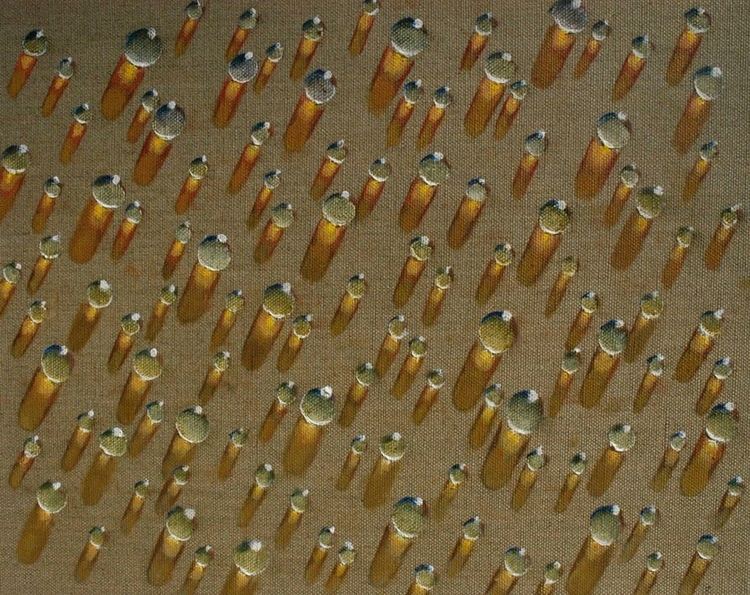
Kim Tschang Yeul is part of the first generation of modern artists in South Korea. He is a prolific painter well known for his 'water drop' paintings, and has been one of the most influential figures in modern Korean art history. Although he started out as part of the Art Informel movement in South Korea, he has lived most of his adult life in Paris, France, where he developed his own unique style of painting.
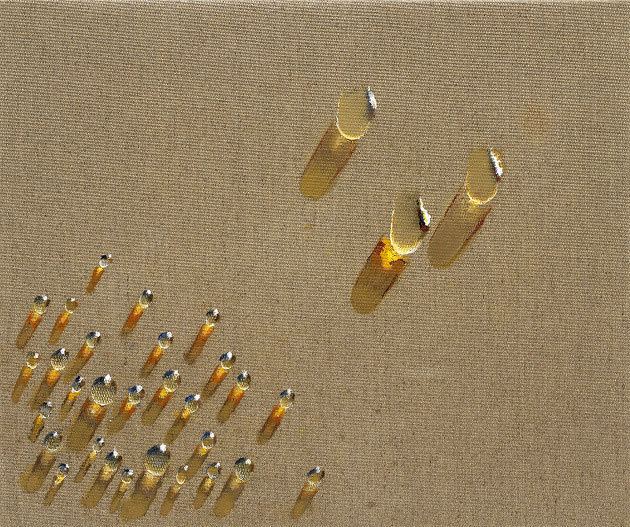
After graduating from the College of Fine Arts at Seoul National University in 1950, Kim led the Korean Art Informel movement with Park Seo-Bo, Se-Ok Suh, Ha Chong-Hyun, and Chung Chang-Sup in the 1950s and 60s. This movement greatly inspired many avant-garde artists of the next generation in rejecting the conservative values imposed on them by Korean institutions.
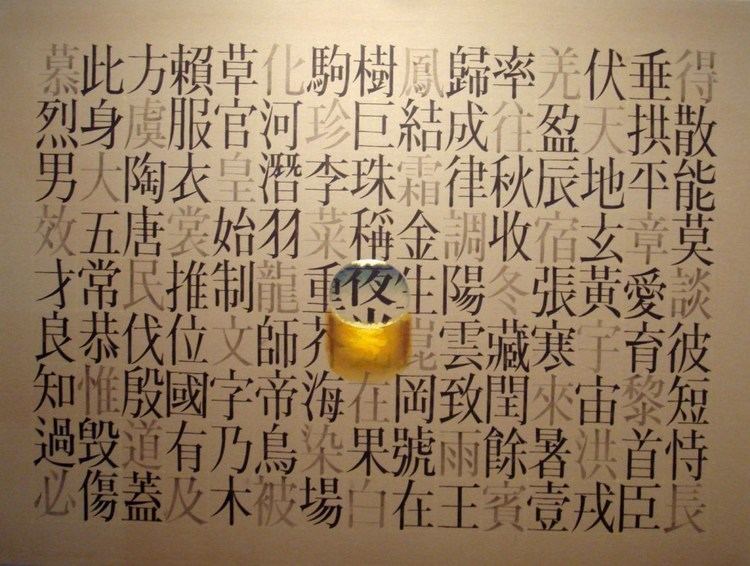
Shortly after his participation in the Paris Biennale in 1961 and the São Paulo Biennale in 1965, Kim moved to New York City and studied at the Art Students League of New York from 1966 to 1968. Kim Tschang Yeul's time spent in New York City allowed him to interact with and be inspired by the Pop art movement, which was a significant influence on him.
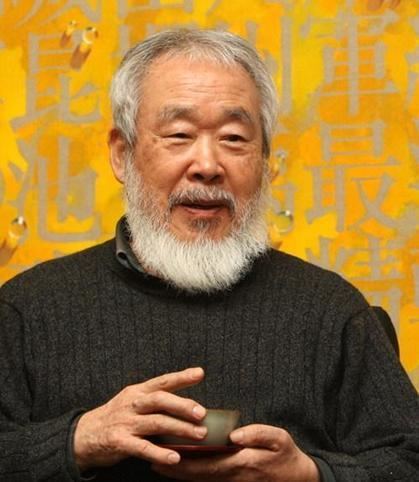
Because of his years abroad, Kim Tschang Yeul developed his art outside of the Seoul and Tokyo art scene, developing his unique style parallel to the Dansaekhwa movement. In 1969, Kim moved from New York City to Paris, where he continued depicting opaque abstract liquid forms.
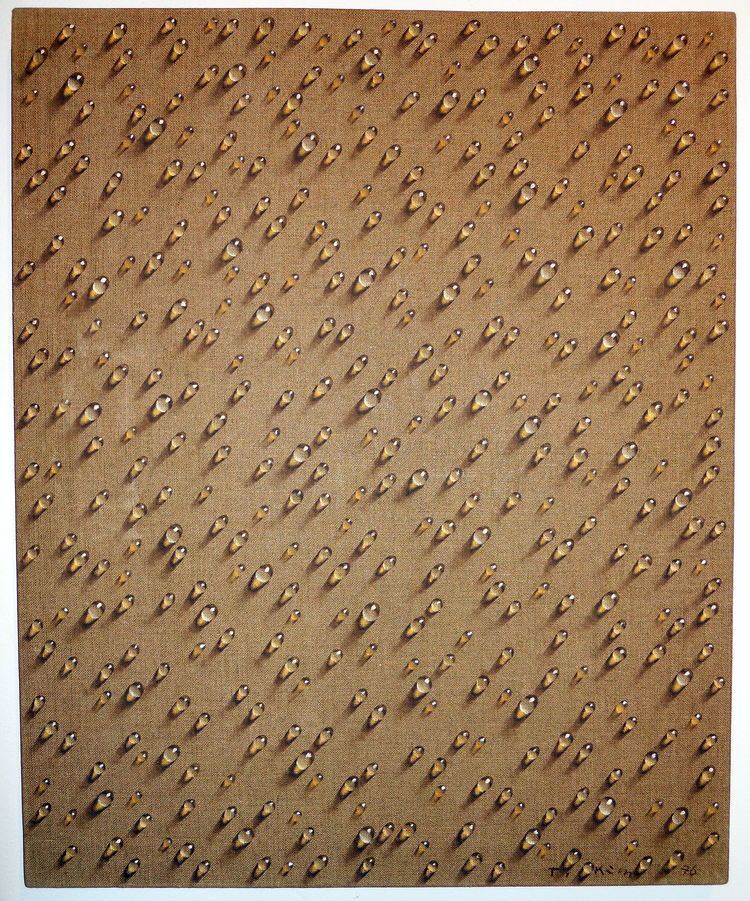
WIth time, the liquid abstract forms transformed into spherical, transparent 'water drops', which have become his distinctive, trademark style after the mid-1970s. The water drops have been Kim’s focus for the past five decades. He has pursued the painting of water drops between Seoul and Paris, where he lives and works.
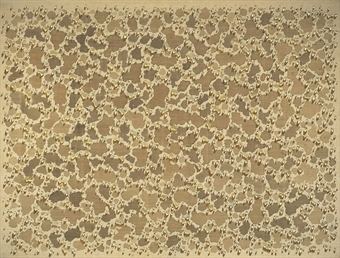
Kim’s water drop paintings speak a language that amalgamates the discourses around photorealism and abstract expressionism, situating themselves in an ambiguous space between reality and the abstract. According to Kim, he does not interpret his subject as realistic depictions of actual water drops, but “idealistic” ones. Kim explains that the continued act of painting water drops helps him erase painful and traumatic memories of serving in the military during the Korean War between 1950 and 1953, where he witnessed the deaths of his fellow soldiers. In a way, the incessant act of painting water drops served as a therapeutic tool for him, bringing his art closer to surrealism and spirituality. Many have speculated about the meaning behind his obsession with water drops.
In 1996, he was awarded the Chevalier medal of the Ordre des Arts et des Lettres bestowed by the Embassy of France in Seoul.
In 2016, the government of Korea opened the Kim Tschang Yeul Museum of Art in Jeju, Jejudo island, South Korea, the highest honor bestowed upon a living Korean artist.
Kim Tschang Yeul is represented by Gallery Hyundai in South Korea and by Pearl Lam Galleries in Hong Kong.
2012 kim tschang yeul solo exhibition
Artwork
"The famous monk Dharma meditated for nine years to achieve spiritual enlightenment, I have been painting water drops for 40 years but wasn't able to reach Dharma's level of enlightenment." -Kim Tschang YeulKim Tschang-yeul is considered the artist that inspired monochromatic painting in Korea, as well as one of the most influential Korean masters in contemporary art in the West. At the time of Japanese colonialism and Korean war, the turmoil of social culture and political history pushed Kim to participate in the movement of contemporary art and establish his self through art. In the 1960s, Kim decided to leave his homeland and sojourned in New York; in the 1970s, Kim made Paris his home. A tranquil morning, sunlight slid in from the window, shining on the canvas sprayed with water the night before. The glistening and sparkling water drops at the moment moved Kim Tschang-yeul so much that he started working on waterdrops. Over the next four decades in Paris, Kim would be doing the same thing: painting water drops. There, then, comes the reputation of the "painter of water drops". In 2004, Kim was invited to display his works in an art show at Galerie Nationale du Jeu de Paume, where he was awarded with the Commandeur medal, the highest honor of the Ordre des Arts et des Lettres.
Water drops are translucent and glistening, nonetheless vanishing within moments. Kim Tschang-yeul's water drops are intimately connected to his life, that is, the wars, poverty, love and pain he's been through. He keeps painting the water drops, over and over, with an attempt to erase the pains and to look for absolute transparency, absolute withering, until he reaches a spiritual state of emptiness. "The process of painting the water drops is to filter, to dissolve all the impurities out of them and return them to a clear state of nothing. When all the rage, anxiety, and fear come to the moment of nothing, we reach a state of peace and comfort." To Kim, the pure clean water drop is a consolation, a remedy for himself, seeking, not forgetting, peace, forgiveness, and reflection between now and the past. Regardless of single drops or in groups, the water drops of Kim Tschang-yeul are sprinkled non-uniformly upon the canvas of sleek or rough surface. It is as if they are falling off the canvas, or they are absorbed by the canvas but afloat, or it is that they are pulled out of the canvas by gravity. And a ray of light gleams from the side, slightly gliding through the isolated water drops, reflecting their crystal clarity. The water drops give the extremely realistic impression made out of fiction, enticing people to touch them. Time also finds its own refraction in the water drops with enormous layers and transparency: every temporary moment that doesn't seem to be is actually permanent existence. How we captures the flashes of our creative mind determines how insightful that particular piece of memory unfolds to us. Kim Tschang-yeul is convinced that he shall make water drops the thematic subject of his painting career, for which he does with such care, details, and joy of art in everyday life, so much so that it paves the way to art for him. By 1972, new Waterdrops works revealed a substantial conceptual shift as opposed to the Phenomenon series which appeared to visualize the quality of existence. Water drop on his canvas was no longer alone. The number of water drops radically increases in all sizes, which turns reality into beauty and reflects the lightness of life and the wonder of existence.
Kim had lived abroad for many years, in the 1980s, he recalled reading and practicing writing when he was a child. Kim decided to draw positive texts from Thousand Character Classic, or deconstruct Chinese letters to compose together with water drops and created the new series Recurrence. It is a return to Kim's cultural origin as well as the origin of his life; it is also a struggle over the reality and illusion of time and space. By the 1990s, Kim began to paint water drops on wooden boards and newspapers like Le Monde, too, actively exploring new media and techniques for his works. In the other hand, he also makes several pieces of works in sculpture, with iron, bronze, or rock as the base, and with glass for water drops as the installation. Kim persists in pushing for extremely refined changes in plasticity as well as exploring the multiple aesthetic values of water. With his personal life force as well as his simple strokes and plain arrangement in the frame, Kim paints what his mind envisions. In this inner world, with all its moments, intervals, stillness and motions, rests a sophisticated life that opens to the universe through the strokes. No matter if it is his Waterdrops from the 1970s or Recurrence of the 1980s and 1990s, Kim structures countless highly realistic water drops in the abstract space. And, with the impermanence of time by which he contemplates, Kim expresses the immensity and nothingness of nirvana and ever-flowing life.
He has said that, "my waterdrops paintings are accomplished under the encounters of my life experiences and my plasticizing experiences." Each clear, impeccable water drop is in its initial state since purification, as if it is a recurrence of absolute nothingness; the water drop is also what it finally returns to."
Kim Tschang Yeul Museum
In 2016, the Kim Tschang-Yeul Museum of Art opened in Jeju, Jejudo island, South Korea, to honor the artist.
Solo exhibitions
A Communion of Beads, Pearl Lam Galleries, Hong Kong, China (2017)
Traces of Beads, Metaphysical Art Gallery, Taipei, Taiwan (2017);
Galerie Baudoin Lebon, Paris, France (2016);
Galerie 75 Faubourg - Galerie Enrico Navarra, Paris, France (2016);
Gwangju Museum of Art, Gwangju, Korea (2014);
National Taiwan Museum of Fine Arts, Taichung, Taiwan (2012);
Busan Museum of Art, Busan, Korea (2009);
National Art Museum of China, Beijing, China (2006);
Gallery Hyundai, Seoul (2004);
Galerie nationale du Jeu de Paume, Paris (2004);
Draguignan Museum, Drauignan, France (1997);
Sonje Museum of Contemporary Art, Korea (1994);
Kongkan Gallery, Pusan, Korea (1994);
SAGA (Matsumura Graphics, Tokyo), Paris (1993);
The National Museum of Contemporary Art, Korea (1993);
Chicago International Art Exposition, Gallery Hyundai, Chicago (1989);
Naviglio Gallery, Milan, Italy (1987);
Tokyo Gallery, Tokyo (1983);
Antwerp Gallery, Antwerp, Belgium (1977);
Kunsthaus, Hamburg, Germany (1975);
Knoll International, Paris (1973).
Exhibitions
2015: Primus Sensus, Galerie Pont des Arts, Seoul, Korea
Onyang Museum, Ansan, Korea
Gwangju Museum of Art, Gwangju, Korea
Korean Abstract Painting, GALLERY HYUNDAI, Seoul, Korea
2014: Kim Tschang-Yeul, Jeju Museum of Art, Jeju
Kim Tschang-Yeul, Gwangju Museum of Art, Gwangju
Masters of Korean Art, Seoul Museum, Seoul, Korea
Botero, Ufan Lee, Tschang-Yeul Kim, Galerie Bhak, Seoul, Korea
Like Cow Walks : Slowly, Steadily, and Far Away, Seoul Museum, Seoul, Korea
Kim Tschang-Yeul & John Bae, Konjiam Gallery, Kyunggi, Korea
The Artistic Spirits of Modern Artists on Paper, GALLERY HYUNDAI, Seoul, Korea
2013: Kim Tschang-Yeul, GALLERY HYUNDAI, Seoul
Kim Tschang-Yeul, National Taiwan Museum of Fine Arts, Taiwan
2012: Pohang Museum of Steel Art, Pohang, Korea
Working with Nature, Park Ryu Sook Gallery, Seoul, Korea
2011: Beyond the Blue, GALLERY HYUNDAI, Seoul, Korea
Lee Hwaik Gallery, Seoul, Korea
2010: Kim Tschang-Yeul: Recurrence, GALLERY HYUNDAI, Seoul
2010 In the Midst of the Korean Contemporary Art, GALLERY HYUNDAI, Seoul, Korea
2009: Busan Museum of Art, Busan
Korean Monochrome, Wellside Gallery, Shanghai, China
2008: Pyo Gallery LA, Los Angeles
Baudoin Ledon Gallery, Paris
Valerie Bach Gallery, Brussel, Belgium
Contemporary Korean Artists in Paris, Seoul Arts Center, Seoul, Korea
Kim Tschang-Yeul & Nam June Paik, GALLERY HYUNDAI, Seoul, Korea
Korean Contemporary Artists, Singapore Art Museum, Singapore
2007: Kim Tschang-Yeul, GALLERY HYUNDAI, Seoul
Seoul Museum of Art, Seoul, Korea
2006: Kongkan Gallery, Busan
Pyo Gallery Beijing, Beijing
Where, in What Form, Shall We Meet Again, GALLERY HYUNDAI, Seoul, Korea
Masters and Leading Artists of Korean Contemporary Art, Lee Hwaik Gallery, Seoul, Korea
2005: Kim Tschang-Yeul, Galerie Bhak, Seoul
The National Museum of China, China
Korean Contemporary 20 Artists, GALLERY HYUNDAI, Seoul, Korea
Guimet Museum of Asian Art, Paris, France
2004: Galerie Nationale du Jeu de Paume, Paris, France
Painting in Korea-Yesterday and Today, Seoul Museum of Art, Seoul, Korea
2002: Work on Paper by 4 Korean Artists, Gallery Bijutsu Sekai, Tokyo, Japan
2001: L’art à la plage, Saint-Tropez, Gallery Enrico Navarra, Paris, France
Monochrome Painting in Korea, Korea Art Gallery, Busan, Korea
KCAF, Hangaram Art Museum, Seoul, Korea
2000: Gallery HYUNDAI/ Galerie BHAK, Seoul, Korea
Navy Pier, Gallery BHAK, Seoul, Chicago, IL
Gallery BHAK, Seoul, Cologne, Germany
Gallery BHAK, Seoul, Tokyo, Japan
1999: Andrew Shire Gallery, Los Angeles, CA
1998: Gallery MMG, Tokyo, Japan
Sakamoto Zenzo Museum of Art, Kumamoto, Japan
1996: Enrico Navarra Gallery, Paris, France
1994: Sonje Museum of Contemporary Art, Gyeongju, Korea
1993: National Museum of Contemporary Art, Seoul, Korea
1992: Tate Gallery, Liverpool, UK
1957–1991: Staempfli Gallery, New York, NY
1989 Kasahara Gallery, Osaka, Japan
1988: Tokyo Gallery, Tokyo, Japan
Seibu Contemporary Art Gallery, Tokyo, Japan
1979: Hyundai Gallery, Seoul, Korea
1978: Staempfli Gallery, New York, NY
Gallery Takagi, Nagoya, Japan
1976: Hyundai Gallery, Seoul, Korea
Participated at the Salon de Mai, Paris
1975: INKO Arts, Galerie Sprick, Bochum, Rome, Italy
Kunsthaus, Hamburg, Germany
1968: Exhibited at the 8th São Paulo Biennale
1961: Exhibited at the 2nd Paris Biennale
Selected Group Exhibitions
2015 MMCA Collection Highlights: Untitled, National Museum of Modern and Contemporary Art, Gwacheon, Korea
2013 A Moment of Truth, Hansol Museum, Wonju, Korea
2012 Thoughts in Korean Modern Art, Pohang Museum of Steel Art, Pohang, Korea
2011 Qi is Full, Daegu Art Museum, Daegu, Korea
2010 Portrait of the Korean War, Museum of Art at Seoul National University, Seoul, Korea
Korean Avant-Garde Drawing, Soma Museum of Art, Seoul, Korea
OFF the WALL, Clayarch Gimhae Museum, Gimhae, Korea
2009 Beginning the New Era, National Museum of Contemporary Art, Seoul, Korea
Art & Chinese Character, Gallery Yookgongsa, Busan, Korea
The Colour of Nature—Monochrome Art in Korea, Wellside Gallery, Shanghai, China
2008 Recomposition of the Works, Gyeongi Do Museum of Art, Ansan, Korea
Korean Contemporary Art Show, Singapore Art Museum, Singapore, Singapore
Contemporary Korean Artists in Paris, Seoul Art Center, Seoul, Korea
In Memory of Moon Mi Aie, Whanki Museum, Seoul, Korea
2007 Writing Paintings, Painting Words, Seoul Museum of Art, Seoul, Korea
Poetry in Motion, Galerie Beyeler, Basel, Switzerland
2006 Kim Whan-Ki, Kim Tschang-Yeul, Lee U-Fan, 1970–1980: Where, in What Form, Shall We Meet Again, Gallery Hyundai, Seoul, Korea
2005 Poem of Indian Ink, Guimet Museum of Asian Art, Paris, France
2004 Painting in Korea—Yesterday and Today, Seoul Museum of Art, Seoul, Korea
2002 Work on Paper by 4 Korean Artists, Gallery Bijutsu Sekai, Tokyo, Japan
2001 L’art à la plage (Art at the Beach), Saint-Tropez, Gallery Enrico Navarra, Paris, France
Monochrome Painting in Korea, Korea Art Gallery, Busan, Korea
Korean Contemporary Art Festival (KCAF), Hangaram Art Museum, Seoul, Korea
2000 Gwangju Biennale 2000 Special Exhibition, The Facet of Korean and Japanese Contemporary Art, Gwangju Museum of Art, Gwangju, Korea
1999 L’art à la plage, Saint-Tropez, Gallery Enrico Navarra, Paris, France
1998 Les peintres du silence, Museum of Art and History, Monbliéard, France
1997 Made in France, Centre Georges Pompidou, Paris, France
1996 Letter and Images, Hanlim Museum, Tae-Jeon, Korea
1994 L’art à la plage, Gallery Enrico Navarra, Paris, France
1992 Working with Nature: Traditional Thought in Contemporary Art from Korea, Tate Liverpool, Liverpool, England
Ecole de Seoul, Kwanhoon Gallery, Seoul, Korea
Hangul, Seoulim Gallery, Seoul, Korea
1991 Ecole de Seoul, Kwanhoon Gallery, Seoul, Korea
1990 Ecole de Seoul, Kwanhoon Gallery, Seoul, Korea
1989 Ecole de Seoul, Kwanhoon Gallery, Seoul, Korea
1988 Olympiad of Art: The International Contemporary Painting Exhibition (sponsored by Seoul Olympic Organising Committee).National Museum of Contemporary Art, Gwacheon, Korea
Contemporary Art and the Olympics: Exhibition of Official Fine Art Posters & Lithographs of the 24th Olympiad Seoul 1988, Lloyd Shin Gallery, Seoul, Korea
1987 Ecole de Seoul, Kwanhoon Gallery, Seoul, Korea
1986 Seoul-Paris, Press Center, Seoul, Korea and Center National des Arts Plastiques, Paris, France
Korean Art Today, National Museum of Contemporary Art, Gwacheon, Korea
1985 Human Documents ’84/’85, Tokyo Gallery, Tokyo, Japan
1984 Korean Contemporary Fine Arts Exhibition—The Stream of the ’70s, Taipei Fine Arts Museum, Taipei, Taiwan
Art Today, Tokyo Metropolitan Art Museum, Tokyo, Japan
1983 Korean Contemporary Arts Exhibition—The Latter Half of the ’70s: An Aspect, Tokyo, Osaka,
Sapporo, Utsunomiya, Fukuoka, Japan
1982 Korean Contemporary Art Phase, Kyoto Municipal Museum of Art, Kyoto, Japan
Works on Paper in Korea and Japan, National Museum of Modern and Contemporary Art, Seoul, Korea; travelled to Kyoto Municipal Museum of Art, Kyoto; The Museum of Modern Art, Saitama; and Kumamoto
Traditional Crafts Center, Kumamoto, Japan
1981 Dealers Eyes, Long Island Museum, New York, USA
Korean Drawing Now, Brooklyn Museum, New York, USA
1980 Asian Artists Exhibition Part 2, Fukuoka Art Museum, Fukuoka, Japan
Festival: Contemporary Asian Art Show, Fukuoka Art Museum, Fukuoka, Japan
Faculty Choices, Albany Museum, New York, USA
Salon des grands et jeunes d’aujourd’hui, Grand Palais, Paris, France
1979 Reality of Illusion Traveling Exhibition, Denver Art Museum, Denver, USA
1977 15th Biennale of São Paulo, São Paulo, Brazil
Korea: Facet of Contemporary Art, Tokyo Central Museum, Tokyo, Japan
Korean Modern Painting, National Museum of History, Taipei, Taiwan
1976 Aspect of Realism, Winnipeg Art Gallery, Winnipeg, Canada
1975 Salon de Mai, Paris, France
1974 Salon de Mai, Paris, France
1973 Salon de Mai, Paris, France
Salon des Réalitiés Nouvelles, Paris, France
12th Biennale of São Paulo, São Paulo, Brazil
1972 Salon de Mai, Paris, France
50 Paintings of Salon de Mai de Paris, Yugoslavia
Festival International de la Peinture (International Painting Festival), Cagnes-sur-Mer, France
8th Prints Biennale of Tokyo, Tokyo, Japan
4 Painters Exhibition, Museum of Saint-Paul-de-Vence, Saint-Paul-de-Vence, France
1971 Korean Contemporary Painting Exhibition, Paris, France
1969 Avant-Garde Festival, New York, USA
1965 8th Biennale de São Paulo, São Paulo, Brazil
1962–64 The Actuel Exhibition, Shinsegae Art Hall, Seoul, Korea
1961 The 2nd Biennale de Paris, Paris, France
Selected Public Collections
Albright-Knox Art Gallery, Buffalo, USA
Aqua Museum 104°, Shimane, Japan
Art Center Nabi, Seoul, Korea
Bochum Museum Art Collection, Bochum, Germany
Busan City Museum of Art, Busan, Korea
Centre Georges Pompidou, Paris, France
Daejeon Museum of Art, Daejeon, Korea
Daegu Art Museum, Daegu, Korea
Daelim Museum, Seoul, Korea
Fondation Veranneman, Ghent, Belgium
Fukuoka Art Museum, Fukuoka, Japan
Fundació Stämpfli, Sitges, Barcelona, Spain
Gwangju Museum of Art, Gwangju, Korea
Hakodate Museum, Hokkaido, Japan
Hansol Museum, Wonju, Korea
Hiroshima Contemporary Museum of Art, Hiroshima, Japan
Hirshhorn Museum and Sculpture Garden, Washington, D.C., USA
Ho-Am Art Museum, Yongin, Korea
Iwaki City Art Museum, Iwaki, Japan
Leeum, Samsung Museum of Art, Seoul, Korea
Museum Boijmans Van Beuningen, Rotterdam, the Netherlands
Museum of Fine Arts, Boston, USA
Museum of Fine Arts, Gifu, Japan
Museum of Modern Art, Saitama, Japan
Museum of Oriental Art, Cologne, Germany
Museum of Texas Tech University, Lubbock, Texas, USA
National Museum of Contemporary Art, Gwacheon, Korea
National Museum of Modern Art, Tokyo, Japan
Niigata Prefectual Museum of Modern Art, Niigata, Japan
Ohara Museum of Art, Kurashiki, Japan
Seoul Museum of Art, Seoul, Korea
Seoul National University Museum of Art, Seoul, Korea
Shimonoseki City Museum of Art, Shimonoseki, Japan
Sonjae Museum of Contemporary Art, Gyeongju, Korea
Sunkyung Museum of Art, Seoul, Korea
Takamatsu City Museum of Art, Takamatsu, Japan
Tokyo Metropolitan Museum of Art, Tokyo, Japan
Walker Hill Art Center, Seoul, Korea
Winnipeg Art Gallery, Winnipeg, Canada
Selected publications
2009 Morgan, Robert C., Kim Tschang-Yeul: The Paradox of Meaning, PYO Gallery, Seoul (in English and Korean).
2008 Sergeant, Philippe, Kim Tschang-Yeul, Éditions de la Différence, Paris (in French and Korean).
2002 Barrière, Gérard, Kim Tschang-Yeul, Galerie Bhak, Seoul (in French and Korean).
2000 Restany, Pierre, “A Bit of the Comet’s Coma”, in Kim Tschang-Yeul, Gallery Hyundai, Seoul (in French).
Restany, Pierre, Kim Tschang-Yeul, Galerie Bhak, Seoul (in English and Korean).
1998 Chiba, Shigeo, “Like Play, Also Like a God”, Tokyo Gallery, Tokyo (brochure).
Shioda, Junichi, “A Word About Kim’s Paintings: The Waterdrops and the Kanji Characters”, in Tschang Yeul Kim: Water Drops—Play and Prayer, Sakamoto Zenzo Museum of Art, Kumamoto (in English and Japanese).
Masuda, Ryoske, “Entretien”, in Kim Tschang-Yeul: Water Drops—Play and Prayer, Sakamoto Zenzo Museum of Art, Kumamoto.
1997 Matheson, John, Kim Tschang-Yeul, Antwerp Gallery, Anvers (in English, Flemish, and French) Byong-Kwan, Jeung, “Notes Verbales”, in Kim Tschang-Yeul, Galerie Bhak/Gallery Hyundai, Seoul (in English and Korean).
1994 Byong-Kwan, Jeung, “The Artist’s Avant-Garde Spirit Seen from the Transition of the Waterdrops”, in Kim Tschang-Yeul: Waterdrops, Sonje Museum of Contemporary Art, Kyongju, pp7–12 (in English and Korean).
Tae-Sung, Kang, “Transformation of the World of Water, Waterdrops”, in Kim Tschang-Yeul:
Waterdrops, Sonje Museum of Contemporary Art, Kyongju, pp13–21 (in English and Korean).
1993 Lee, Yil, “Kim Tschang-Yeul’s ‘Water Drops’ oeuvre and its path”, in Kim Tschang-Yeul, National Museum of Contemporary Art, Gwacheon, pp48–60 (in English and Korean).
Cohen, Ronny, Kim Tschang-Yeul, Hudson Hills Press, New York.
Kyong-Soo, Lee, “Literature on Water Drops”, in Kim Tschang-Yeul, National Museum of Contemporary Art, Gwacheon, pp30–37 (in English), pp25–29 (in Korean).
Cyroulnik, Philippe, “Kim Tschang-Yeul”, in Kim Tschang-Yeul, National Museum of Contemporary Art, Gwacheon, pp73–75 (in French and Korean).
Oh, Kwang-Soo, “Kim Tschang-Yeul’s ‘Drops of Water’ as the Essence of Consciousness”, in Kim Tschang-Yeul, National Museum of Contemporary Art, Gwacheon, pp30–37 (in English and Korean).
Restany, Pierre, “The Other Place”, in Kim Tschang-Yeul, National Museum of Contemporary Art, Gwacheon, pp25–29 (in French and Korean).
Bosquet, Alain, in Kim Tschang-Yeul, National Museum of Contemporary Art, Gwacheon, pp115–119 (in French and Korean).
Barrière, Gérard, in Kim Tschang-Yeul, Galerie Enrico Navarra, Paris, pp11–27 (in French and Korean).
Barrière, Gérard, in Kim Tschang-Yeul, Gallery Hyundai, Seoul, pp28–38 (in French, English, and Korean).
Cohen, Ronny, in Kim Tschang-Yeul, National Museum of Contemporary Art, Seoul, pp61–71 (in English and Korean).
Cohen, Ronny, in Kim Tschang-Yeul, Galerie Enrico Navarra, Paris, pp69–78 (in French and English).
Cohen, Ronny, in Kim Tschang-Yeul, Gallery Hyundai, Seoul, pp102–116 (in French, English, and Korean).
Byong-Kwan, Jeung, in Kim Tschang-Yeul, National Museum of Contemporary Art, Seoul, pp77–95 (in French and Korean).
Kwang-Soo, Oh, in Kim Tschang-Yeul, Gallery Hyundai, Seoul, pp7–12 (in English and Korean).
Restany, Pierre, in Kim Tschang-Yeul, Galerie Enrico Navarra, Paris, pp7–10 (in French and English).
Restany, Pierre, in Kim Tschang-Yeul, Gallery Hyundai, Seoul, pp17–25 (in French, English, and Korean).
Ufan, Lee, in Kim Tschang-Yeul, National Museum of Contemporary Art, Gwacheon, pp97–105 (in English and Korean).
Matheson, John, in Kim Tschang-Yeul, National Museum of Contemporary Art, Gwacheon, pp107–113 (in English and Korean).
Barrière, Gérard, “Notes on Kim Tschang-Yeul or The Universe After the Rain”, in Kim Tschang-Yeul, National Museum of Contemporary Art, Gwacheon, pp38–47 (in French and Korean).
1991 Cohen, Ronny, “Introduction”, in Kim Tschang-Yeul, Sigma Gallery/Staempfli Gallery, New York (in English).
Yil, Lee, “Kim Tschang-Yeul’s 1000 Characters and Water Drops”, Inkong Gallery, Daegu (brochure in Korean).
Yil, Lee, Kongkan Gallery, Busan (catalogue in Korean).
1988 Yil, Lee, “Kim Tschang-Yeul and a Water Drop”, Gallery Hyundai, Seoul (brochure in Korean), Tokyo Gallery, Tokyo (in Japanese).
Moriguchi, Akira, “Kim Tschang-Yeul—Luminous and Fresh Paintings”, in Tschang-Yeul Kim, Seibu Contemporary Art Gallery, Tokyo (in Japanese).
1987 Wolff, Theodore F., “Tschang-Yeul Kim”, Staempfli Gallery, New York (brochure in English).
1983 Yil, Lee, “This is Not a Water Drop”, Tokyo Gallery, Tokyo (brochure in Japanese).
1979 Bosquet, Alain, “The Waterdrops of Kim”, in Kim Tschang-Yeul, Staempfli Gallery, New York, pp30–37 (in French and English).
Byong-Kwan, Jeung, “Painting of Another Genre”, in Kim Tschang-Yeul, Staempfli Gallery, New York, pp8–27 (in French and English).
Ufan, Lee, “Entre l’idée et la matière” (“Between the Idea and the Material”), in Kim Tschang-Yeul, Staempfli Gallery, New York, pp38–39 (in French and English).
Matheson, John, in Kim Tschang-Yeul, Staempfli Gallery, New York, pp48–55 (in French and English).
Staempfli, George W., “Introduction” in Kim Tschang-Yeul, Staempfli Gallery, New York, pp6–7 (in French and English).
1978 Ufan, Lee, “Fra l’idea e la material” (“Between the Idea and the Material”), Galleria del Naviglio, Milan (in Italian).
Staempfli, George W., Staempfli Gallery, New York (brochure in English).
1976 Bosquet, Alain, “Les gouttes de Kim” (“The Drops of Kim”) in T. Kim, Gallery Hyundai, Seoul (in French and Korean).
Yil, Lee, “To Brother Tschang-Yeul”, in T. Kim, Gallery Hyundai, Seoul (in French and Korean). Nakahara, Yusuke, Tokyo Gallery, Tokyo (brochure in Japanese).
1974 Bosquet, Alain, “Die Wassertropfen von Kim” (“The Water Drops of Kim”), Galerie Sprick, Bochum (in German).
Bosquet, Alain, “20 gouttes d’eau pour Kim” (20 poemes) (“20 Water Drops by Kim”, 20 poems) in Kim, Gouttes d’eau (Kim, Water Drops), Galerie Engelberts, Geneva.
1973 Leuwers, Daniel and Ryoske Masuda, Knoll International, Paris (brochure).
Pre-1973 Yil, Lee, Kasahara Gallery, Osaka (brochure in Japanese).
Matheson, John, “Merely Drops of Water?”
Restany, Pierre, in Kim Tschang-Yeul, Galerie Bhak, Seoul (in English and Korean).
Lewis Biggs. Working with Nature: Traditional Thought in Contemporary Art from Korea: Chung, Chang-Sup; Yun, Hyong-Keun; Kim, Tschang-Yeul; Park, Seo-Bo;
Lee, U-Fan; Lee, Kang-So.este señor a creado en sus dibujos el relieve
Ronny Cohen. Tschang Yeul Kim.
Writings by the Artist
1962 “My Vision”, Taehan Ilbo, Seoul, 1 January 1962.
1960 “Note”, Hanguk Ilbo, Seoul, 24 January 1960.
1960 “The Problem of 30 Years”, Segye Ilbo, Seoul, 31 May 1960.
1960 “The Advance of the Avant-Garde”, Jayu Munhak, Seoul, December 1960.
1958 “Secret Words”, Hanguk Ilbo, Seoul, 11 January 1958.
